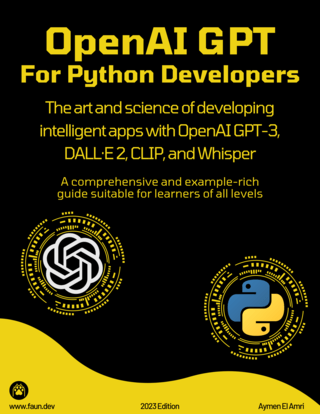
English | 2023 | ISBN: NA | 235 Pages | PDF, EPUB | 19 MB
Explore the fascinating world of Artificial Intelligence and solve real-world problems!In this practical guide, you will build intelligent real-world applications using GPT-3, DALL-E, Whisper, CLIP, and more tools from the OpenAI and ML ecosystem.Rest assured, you don't need to be a data scientist or machine learning engineer to follow this guide.
The knowledge you gain from this guide will be applicable to GPT-3 and will likely also be relevant to GPT-4, should it ever be released.
OpenAI provides APIs (Application Programming Interfaces) to access their AI. The goal of an API is to abstract the underlying models by creating a universal interface for all versions, allowing users to use GPT regardless of its version.
The goal is to provide a step-by-step guide to using GPT-3 in your projects through this API but not only - many other tools and models built by OpenAI such as Whisper (an automatic speech recognition (ASR) system trained on 680,000 hours of multilingual and multitask supervised data), CLIP (Contrastive Language-Image Pre-Training), a neural network trained on a variety of (image, text) pairs and DALL·E 2, a new AI system that can create realistic images and art from a description in natural language.
Whether you're building a chatbot, an AI (voice) assistant, a semantic search engine, a classification system, a recommendation engine a web app providing AI-generated data, or any other sort of natural language/image/voice processing and generation platform, this guide will help you reach your goals.
If you have the basics of Python programming language and are open to learning a few more techniques like using Pandas Dataframes and some NLP techniques, you have all the necessary tools to start building intelligent systems using OpenAI tools.
Rest assured, you don't need to possess the title of a data scientist, machine learning engineer, or AI expert to comprehend the concepts, techniques, and tutorials presented in this guide. Our explanations are crystal clear and easy to understand, employing simple Python code, examples, and hands-on exercises.
This guide is focused on practical, hands-on learning and is designed to help the reader build real-world applications. The guide is example-driven and provides a lot of practical examples to help the reader understand the concepts and apply them to real-life scenarios to solve real-world problems.
By the end of your learning journey, you will have built applications such as
A fine-tuned medical chatbot assistant
An intelligent coffee recommendation system
An intelligent conversational system with memory and context
An AI voice assistant like Alexa but smarter
A Chatbot assistant to help with Linux commands
A semantic search engine
A news category prediction system
An image recognition intelligent system (image to text)
An image generator (text to image)
and more!
By reading this guide and following the examples, you will be able to
Understand the different models available, and how and when to use each one.
Generate human-like text for various purposes, such as answering questions, creating content, and other creative uses.
Control the creativity of GPT models and adopt the best practices to generate high-quality text.
Transform and edit the text to perform translation, formatting, and other useful tasks.
Optimize the performance of GPT models using the various parameters and options such as suffix, max_tokens, temperature, top_p, n, stream, logprobs, echo, stop, presence_penalty, frequency_penalty, best_of, and others.
Stem, lemmatize, and reduce your bills when using the API
Understand Context Stuffing, chaining, and practice using advanced techniques
Understand text embedding and how companies such as Tesla and Notion are using it
Understand and implement semantic search and other advanced tools and concepts.
Creating prediction algorithms and zero-shot techniques and evaluating their accuracy
Understand, practice, and improve few-shot learning.
Understand fine-tuning and leveraging its power to create your own models.
Understand and use the best practices to create your own models.
Practice training and classification techniques using GPT.
Create advanced fine-tuned models.
Use OpenAI Whisper and other tools to create intelligent voice assistants.
Implement image classification using OpenAI CLIP.
Generate and edit images using OpenAI DALL-E 2.
Draw inspiration from other images to create yours.
Reverse engineer images' prompts from Stable Diffusion (image to text)
Download From Rapidgator
Download From Ddownload
To Support My Work Buy Premium From My Links.





